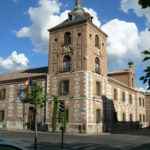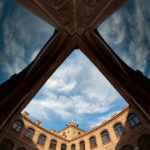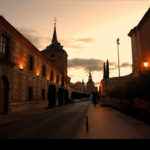Este texto también está disponible en español
One of the most notable buildings of plaza de Cervantes, Colegio de Málaga, dates back from the seventeenth century and is currently the faculty of Philosophy and Humanities.
Colegio de Málaga, or Minor Hall of Residence of San Ciríaco and Santa Paula—its official name—, in a building filling the hole at the end of plaza de Cervantes, visto desde la calle Mayor. Able to be seen from calle Mayor, it shows the typical Alcalá’s print of the towers, elegantly placed on the top of its corners. Today, this is the head of the Faculty of Philosophy and Humanities, and hides one or two legends full of identity and tradition.
People of Málaga
Colegio de Málaga owes its popular name to its firsts students-inhabitants, a dozen specialized in Theology and four studying Canon Law—the intern of Catholic Church—were precisely from the Andalusia city.
Besides, its founder, bishop Juan Alonso de Moscoso, was also Málaga’s bishop—as it façade’s Latin inscription reads, between the first and the second floor—after having being student and professor of Alcalá’s university. In addition, his nephew, Don Juan Arias de Moscoso, who was also dean of Málaga, can also be considered as co-founder. He gave to the city an important quantity of ducats—coins from such period—for encouraging the students of Málaga to study in there.
Anyway, the official name was conferred by bishop Moscoso to honor the saints Ciríaco and Paula, martyred by the Roman emperor Diocletian in the year 303 in Málaga, from which they are Catholic patrons.
However, colegio de Málaga is also known with other name, nothing to do with Málaga, but with Madrid. That is colegio de la Paloma, as Virgen de la Paloma is the religious patron of Madrid, City Hall from which it depended on for a while.
The School of Madrid’s Paloma
The school was founded in 1610, but its construction was not started until 1623 due several ups and downs, from economic troubles to the friction with other near university colleges. These resulted in the initiation of construction, its blocking, its taking up… and so, students even occupied the building before it was completely finished in 1684.
The design of the building was made by the royal architect Juan Gómez de Mora and its construction was undertook by Alcalá’ foreman Sebastián de la Plaza. In there, several bishops and archbishops studied, doctors and canons and even a viceroy—that of New Spain, current Mexico—, don Juan Ortega y Montañés.
As it happened regular through the university of Alcalá’s history, the school suffered several ups and downs along its history, and for example, at the end of eighteenth century, schools of León, Lugo and Aragón were merged.
When Napoleon invasion took place, it suffered great damages in a fire in 1809, which favored sackings and, in consequence, even more pillaging. In 1836, with the Ecclesiastical Confiscations of religious goods, the building ceased being university hall of residence, and allocated as a school-barracks as until 1843, and as artillery academy and military blacksmith, before being restored and turned into archive four years later.
In 1858, the civil governor of Madrid decided to allocate old people’s home into the building for old women and girls without economic resources, that of San Bernardino, for what several works were made in its interior. Old people’s house depended only on Madrid’s City Hall, afterwards changed to host only girls under the protection of Madrid’s patron, Nuestra Señora de la Paloma.
Later on, after being locked in several periods, it was re-occupied by troops during the Civil War. In the fifties of last century, the City Hall re-allocated it as a boarding school, until it was acquired by the University of Alcalá in 1985, and destined to the faculty of Geography and History, re-starting the teaching activity—the only purpose of its founders, the Moscoso, from the very beginning.
The Font of Fidelity
When you observe the façade of the building, among everything, two wonderful turrets — with its slate capital, its spire and even its weathercock—stand out. They are also relevant the two great doors with its Roman arches, both present today—the main one, still main entrance, and the left or East one, old wagon entry.
Colegio de Málaga served as a model for Madrid Baroque architecture. It has two big gardens full of arches linked by using a great flight of steps of Empire style—from Napoleon period.
In one of them, the famous Baroque font of Boca de León is founded. Designed by Miguel de Arteaga in 1765, it is a font with a lion head and an open mouth sculpted. This fount symbolize an old legend saying that, if a man swear fidelity to his lover and after he cheated on her; if he put his hand into the lion’s mouth, it would devour it, so it was used to prove the fidelity of boyfriends, husbands and lovers.
Additional Information:
Useful information:
- Address: Calle Colegios, 2
- Telephone: +34 91 885 44 32
Access from Madrid
- Renfe Cercanías railroads C-1, C-2 and C7A.
- Bus nº 223 (departure from Avenida de América Interchanger).
Image gallery:
On video:
Where is it
Sigue disfrutando de Dream Alcalá:
- Telegram: Recibe nuestras noticias y contenido exclusivo (clic aquí).
- Newsletter: Recibe cada tarde un correo con nuestras últimas noticias (clic aquí).
- YouTube: Suscríbete para ver nuestros mejores vídeos (clic aquí).
 Sé tú el periodista: envíanos tus fotos o noticias a través de Telegram.
Sé tú el periodista: envíanos tus fotos o noticias a través de Telegram.























